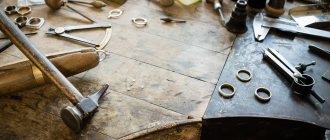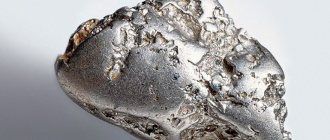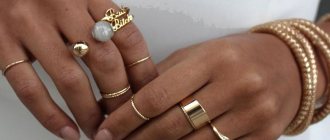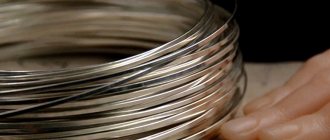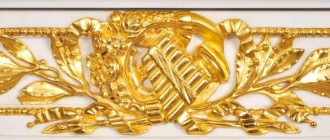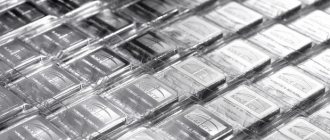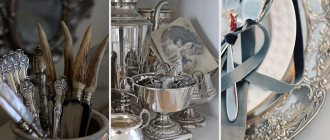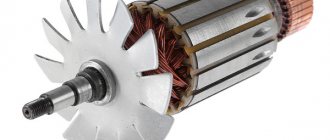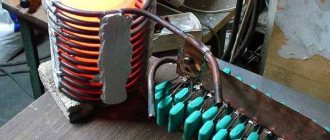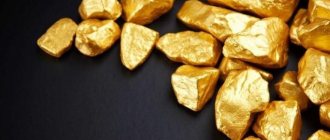Silver is a beautiful noble metal from which jewelry, coins, home decoration and dishes are made. And although silver items are counterfeited less often than gold items, sometimes it becomes necessary to verify the authenticity of the metal. How to test silver at home, read our article.
Pure silver has a silvery-white metallic hue and is highly reflective. However, if it is not cleaned for a long time, it darkens and becomes dull.
Sample and stamp
In order to check the authenticity of silver, first of all inspect the product for the presence of hallmarks and hallmarks.
The mark may look arbitrary, and sometimes be completely absent from the product. As for fineness, silver items sold on the international market must have a marked hallmark indicating the fineness of the metal. The most common numbers are 800, 830, 875, 925, 960; pure silver – 999 standard.
Do not be upset if you cannot find marks on the product - this does not mean that this is a different metal. Such a product may simply not be certified or produced in a country where the mark is not required.
The numbers on the marking indicate the percentage of silver in the alloy. For example, the 925 stamp indicates that the alloy contains 92.5% silver, and the 900 stamp indicates 90% silver content
There are other ways to test your silver. Let's take a closer look at them.
How to distinguish silver from fake
Jewelry, cutlery and decorative items may be common counterfeits. And it doesn’t matter where you got them from - bought in a store, given as a gift, or passed on by inheritance. And even a test will not help here (it can also be faked). To check the authenticity of silver at home, you do not need to have the skills of a jeweler, just a little attention and read our article to the end.
Here are some simple ways to recognize whether it is silver or not on your own and using available tools.
By eye and touch
Fake silver items are very similar to real ones. And for the untrained eye, distinguishing real silver from fake can be quite difficult. But it is still possible.
- Look. Rub your fingers over the product for about a minute and see if your hands are clean. If you notice a dark coating on your fingers, then it is fake. The thing is that scammers often mix silver with zinc, and it is the large percentage of zinc in the product that leaves dark marks on the skin.
- Listen. Hit the silver objects against each other or any hard surface. Real silver sounds loud and bright, while fake silver sounds dull.
- Touch it. Silver has good thermal conductivity. Hold the silver ring in your fist and hold it for a while. Real silver will quickly heat up and reach body temperature.
Iodine
A small drop of iodine will help identify silver. All you have to do is apply a little iodine to the item and see. The area of contact with the substance will quickly darken. If, on the contrary, a white limescale deposit forms on the product or nothing happens at all, then it is a fake.
But! It is impossible to completely remove iodine stains from natural silver objects (only by grinding). Therefore, test silver with iodine only on the inside of the product.
Checking for sonority
This is how coins or silverware are usually tested. Silver will produce a ringing, sparkling sound, while fake will sound dull. To know for sure what real silver sounds like, try it on items that you are absolutely sure are authentic.
Magnet
You can find out whether the silver is in front of you or not using a magnet (use any souvenir magnet from the refrigerator). Natural silver is not magnetic. If the product is attractive, then it is a fake. But there are nuances: many metals, such as cupronickel or aluminum, are also not magnetic. That is, this method cannot be considered 100% reliable. And it is better to double-check the item for authenticity in another way.
Vinegar
To check, take regular table vinegar and place the product in it. If it is silver, nothing will happen, but if there is any reaction, this is a fake.
lapis pencil
This is a fairly old and accurate method for determining the authenticity of silver.
- Go to the nearest pharmacy and buy a lapis pencil. The issue price is about 100 rubles.
- Dip a pencil in water and run it over the surface of the object.
- If the silver is fake, it will leave a mark in the form of a black stripe.
Thermal conductivity
As we have already written, silver is an excellent conductor. If you cannot feel how hot the product is by touch, try using hot water. Place the item to be tested in water for a few seconds, then remove it and touch it. Genuine silver will be hot. For comparison, you can take any metal object and compare it with the silver being tested.
Chalk
A fairly simple and reliable way to recognize silver. Take a school chalk and rub the decoration with it; if dark marks remain on the chalk, the product is real.
Sample and stamp
Pure silver is not intended for the production of household items and jewelry; it is too soft and malleable. Therefore, craftsmen mix silver with other metals in different proportions to give durability and strength. The percentage of silver in such alloys is called fineness. For example, 925 standard means that per 1000 g of alloy there are 925 g of silver and 75 g of impurities.
A stamp with a digital designation of the hallmark must be on all items made of precious metals. This means that the product has passed mandatory state assay control. But, alas, the presence of a sample and a hallmark does not guarantee the authenticity of the jewelry.
Many people believe that if there is a sample, then it is definitely silver. Unfortunately, it is not. And few people know what the original sample should look like.
- A fake is most often made of soft metals, which means the contours of the sample will be softer. There is no such thing in the original.
- There are traces of adhesions. Sometimes scammers transfer the original mark from one item to another (for example, from a silver spoon to a ring). In this case, upon closer examination, you can see the place of soldering.
- The wear of the product and the mark differs. When examined under a magnifying glass, you will notice a difference in the wear of the product itself and the mark; it will be more recent.
Sulfuric ointment
In this method the essence is the same as with iodine. Apply a small amount of ointment to the surface of the object and leave for 30-50 minutes. If the product has darkened, it is real silver.
But you can easily remove a dark stain using ammonia or soda.
Bleach
The same principle applies here. If the jewelry has darkened due to exposure to chlorine, it is original. Although the method is reliable, it is still not recommended to use it on earrings or chains, but such a test can be carried out on the inside of a ring.
Nitric acid
Sold in any pharmacy and gives a quick result of an authenticity experiment at home. Blackened - real, no - fake. But be careful and wear gloves when testing.
Physical impact
Using a sewing needle, you can check whether an item is silver plated or not. Make a light scratch. If a mark remains and the surface is deformed, it is a fake. The needle will not leave any scratches on real silver.
Magnet
Silver, like gold, is diamagnetic, so you can quickly check its authenticity using a magnet.
Bring a magnet to the item - if it is magnetic, it means that it is either a silver-plated item or made of another metal. If the item is not magnetic, there is a very high chance that it is real silver.
Testing with a magnet may not give the desired result if the main alloy material is copper. So, cupronickel and brass (copper alloys) will not be attracted to a magnet
Checking old silver items
Nowadays, silver is affordable for all segments of the population, so there is no need to counterfeit it, which cannot be said about antique jewelry or art objects.
They can be found in antique shops, private collections, or at grandma's flea market. Of course, they will not have a modern hallmark, and the master’s mark may be a fake.
It is better not to approach such items with iodine or nitric acid. You should have knowledge about the era of that time, the specifics of the decor, and, armed with a magnifying glass, a connoisseur will be able to visually determine the authenticity of a silver item.
Thermal conductivity
Silver has the highest thermal conductivity among metals - it heats up quickly and gives off heat just as quickly. Try temperature tests with the product.
If you have a coin or bar in your hands that needs to be checked for authenticity, use ice
Take an ice cube, place it on the product and observe carefully. If the ice melts quickly, as if it were placed on something very warm, you have silver in front of you. This test is suitable for flat items; it does not work well on small jewelry.
You can check a small piece of jewelry by simply picking it up - after a few seconds, the silver item will reach the temperature of your body. If you immerse a silver object in hot water for a moment, it will heat up to the temperature of the liquid in a matter of seconds.
Remember that silver darkens due to high temperature exposure, and in order to return it to its original appearance, you will have to clean the product
Grandma's tips
In jewelry, metal is not used in its original, pure form (the same applies to the production of cutlery). Other components are added to the alloy, which give additional strength. The classic option here is copper. To distinguish real silver from a fake, you need to talk not about Ag as such, but about the percentage of its content in the alloy.
of people living today were able to determine the purity of metal without any drugs or devices
- Argentum is very thermally conductive - it heats up quickly and cools down quickly. If you hold it in your fist, it will immediately acquire body temperature. You can put it in boiling water (if the decoration does not have stones) and then pick it up. Real metal will burn, but not for long.
- The product can be rubbed in your palms for several minutes. If the skin remains clean, the alloy is good; if dark traces remain, there are excess impurities (most often zinc).
- Silver ringing is not just a stable phrase. When gently tapped, the jewelry rattles; the argentum vibrates lightly and protractedly. The percussion instrument should be something akin to a knitting needle.
- If you place a spoon made of Ag in the sun, it will brightly reflect the rays and shine. A cheap alloy will give a dull glow, or even a barely noticeable one.
- People with a keen sense of smell (and good experience) distinguished silver by smell. They assured that pure metal smelled of freshness and lily of the valley. Now this method is hardly suitable for everyone - modern perfumery will make even iron smell like roses.
- Argentum has a high density. Even a small product made from it should be felt in your hand. And today it is so easy to distinguish silver from much lighter aluminum.
- Previously, the ring was covered with crumbs of rye bread and left there for two days. If the jewelry noticeably turned black during this time, this was a good sign - the alloy was considered to be of high quality. With today's bread this test may not pass.
- You can try to bend the spoon (plate). An object made of normal argentum will yield quite easily and will have almost no spring. But this method will not give a 100% guarantee: you can also bend a steel device. And it will be difficult to return the item to its original appearance.
All these tests were based on knowledge of the properties of Ag. Knowledgeable people could determine the authenticity of the metal by its appearance. This is probably still available to experienced jewelers.
Voice test
This test is suitable for checking coins. When tapped, silver makes a ringing sound (especially if it is tapped with another metal). If you already have a proven silver coin, its ringing can be taken as a standard.
Gently tap the silver item (you can use another coin for this): if when you tap you hear a beautiful, open ringing, then this is real silver. If the sound is dull, it means there is little or no silver in the alloy.
A silver service can become a family heirloom and be inherited from generation to generation
Design and types
A search magnet is capable of finding, capturing and lifting metal objects whose weight is much greater than the device itself by 50-100 times. The device is otherwise called an eternal or powerful magnet.
The working fluid consists of a neodymium magnet (contains Nd-Fe-B) enclosed in a glass-shaped turned steel body.
The body is coated with zinc, and the body is coated with nickel, which allows to be used for searching in water .
The housing protects and shapes the magnetic field in the correct direction. There are:
- Single-sided - convenient for searching from a boat, pier, bridge.
- Double-sided - have a universal purpose.
- Trawls are good for examining the bottom of reservoirs.
- Rods – for narrow and hard-to-reach places for conventional magnets.
They also differ in body diameter and magnetic strength .
A special bolt (eye bolt) is screwed into the top or side, intended for a cable or rope.
The second function of the bolt is that it is used to remove an object from a magnet.
To do this, the eye bolt is screwed completely into the body, after which the magnetized object can be removed.
Search magnets are most afraid of high temperatures (above +80); when exposed to strong heat, they lose their functions .
It is easy to work with: having attached it to a rope or cable, it is simply lowered into the desired place.
Objects containing ferromagnetic metals will be attracted to the device. Together with a magnet, they can be removed to the surface.
lapis pencil
You can buy a lapis pencil at a pharmacy. It is often used for testing precious metals at home.
Wet the product and make a mark on it with a lapis pencil: if the metal changes color, then this is a sign of a fake. Since lapis consists of silver nitrate, it does not react in any way with either silver or gold.
Lapis pencil is a somewhat outdated remedy, and you can’t buy it at every pharmacy.
Folk tips and signs for using silver in everyday life
Humanity learned about the unique properties of silver more than 6,000 years ago, and perhaps much earlier. It has long been believed that this amazing metal is capable of absorbing negative energy, which is why it turns black. From a scientific point of view, it reacts with substances and trace elements found in the human body. If there is an imbalance in the body, then silver reacts sensitively to all changes.
- To reduce high fever, wear a silver bracelet on your left hand.
- Earrings improve alertness and concentration.
- If you apply silver to your forehead, you can get rid of headaches and relieve eye strain.
- A ring on the ring finger of the left hand strengthens the heart muscle.
- If silver jewelry quickly darkens on a person, it means that he has health problems.
- Silver dishes and cutlery are good for health.
- Babies are given a silver spoon when their first tooth appears to strengthen the body. Of course, it must be used and not kept as a souvenir.
Sulfuric ointment
You can check the authenticity of silver at home using sulfur ointment (sold in pharmacies).
Apply the ointment to a small area of the product and wait 2 hours. Remove it from the surface with a dry cloth and carefully inspect the treated area: if the surface has darkened, this is silver; if it has acquired a different shade or remains unchanged, the product is made of a different metal.
The test with sulfur ointment is also carried out in another way: a small area of the product is rubbed with fine-grained sandpaper and lubricated with sulfur ointment. After 15 minutes, the result is assessed. If there is a dark spot left on the treated area, then there is a high probability that this is real silver. Metals such as nickel or stainless steel will not interact with sulfur ointment, and, accordingly, no stains will remain on the product.
To remove dark spots left after sulfur ointment, you can wipe the product with ammonia or put it in a soda solution.
What is it, high-quality silver
- Products based on high-quality alloy have 925 standard. You can find the corresponding mark on the back of the jewelry. If the area is thin and hard to see, use a magnifying glass.
- The mark on the product indicates that this is real silver. You should not buy jewelry with a value lower than this. Often, zinc is mixed into such alloys, which promotes rapid darkening.
- Silver jewelry comes with a tag - a passport. The document contains all the data regarding the purchased product. From this information you will find out the exact weight of the jewelry, the presence of stones and their size, and the standard of silver.
- High-quality jewelry of this kind should not contain zinc. It has a negative effect on the skin and reduces the durability of silver. Look for the “Zink Free” label on the label.
- It is rare to find counterfeit silver in our country. However, you should not buy jewelry in underground passages, markets and short-term fairs. Go to a jewelry store that provides a guarantee on its products.
Iodine and chalk
You can test silver with iodine.
In order not to spoil the product, carefully apply a small drop of iodine to the inner surface of the metal - a dark stain will remain on real silver. You can remove traces of iodine after testing in the following way: place the product in a bowl with grated potatoes or sprinkle with starch - under the influence of starch, traces of iodine will change their color and acquire an imperceptible bluish tint, merging with the color of silver.
Chalk not only checks, but also cleans silver. Crushed chalk is mixed with ammonia and the silver items are wiped with a soft cloth.
A similar test can be carried out using ordinary chalk. Rub the silver with a piece of chalk: a dark spot will form on the metal at the point of contact. If the blackness does not appear, you have a fake silver.
You can clean your jewelry using available products. Read how to do this in our article “How to clean silver at home.”
Some interesting facts about silver
Argentum, or silver, is in the same group with gold and platinum in the periodic table. These precious metals do not corrode and do not oxidize in air.
Silver has always been considered a magical substance with mysterious and miraculous properties. It is not only famous for its healing qualities, but also absorbs negativity and helps cleanse the spirit. That is why it is used in church and temple rites in almost all religions of the world. And in the times of the pagans it was associated with the Moon.
Silver infused water has healing properties, and regular use can significantly improve your health. By the way, astronauts on the ISS drink only silver water. And in Japan they have developed devices that purify the air using silver ions.
Do you know that silver jewelry is more popular than gold jewelry? Despite the fact that the shade of this metal is cold, people felt inner warmth and radiance, and happily wore and continue to wear silver jewelry. Precious stones in a silver frame are especially beautiful; they play with all colors and look catchy and contrasting.
Delicious recipe! Recipes from fermented milk products, grade 7
Vinegar
You can test silver with vinegar.
Pour the 9% table bite solution into a bowl and lower the product into the container for a few seconds. Since silver is a low-reactive metal, it will not react with vinegar. If a white coating appears on the product or other changes occur, this is a fake.
You can use a bite to clean silverware and dishes until they shine.
Metal properties
For at least six thousand years, humanity has known what silver looks like. The white (now we can add metallic to this definition) shine most likely attracted the first people to its nuggets. Initially, argentum found application in the manufacture of weapons and jewelry, but not only.
The properties of argentum noted by ancestors determine its use today:
- Silver was placed in water (or kept in containers made of this metal). The metal killed harmful microbes. Christian priests still use this method now, and there are special products for water purification and Ag-based bactericidal medicines on sale.
- “If I make silver water, I have excellent taste,” the Russian Empress Catherine II noted. Metal ions are still used today in the bottling of mineral waters. It is believed that it gives not only a healing, but also a rejuvenating effect.
- The metal was used as talismans against evil spirits, and weapons made from it were used to fight black forces. Silver amulets are also popular in the 21st century. Any jewelry made from it can be considered as such.
- Ancestors made mirrors from metal. Ag has ideal reflective properties. Nowadays, high-precision mirrors are made from it, which are used in science and technology.
- Despite its refractoriness, silver is very ductile and easy to process. Therefore, jewelry made from it is unique and varied. The finest silver threads are used in optics and electrical engineering.
This is a truly unique metal with rich properties. Previously, shiny coins were placed in milk to prevent it from turning sour longer. Nowadays, some elements for underwater vehicles and spacecraft are made from argentum, which can support enormous loads. Silver will surely take a person into the distant future.
Nitric acid
You can test silver using nitric acid - this test is considered one of the most accurate.
Wear gloves and a protective mask, select an inconspicuous area on the product, lightly scratch it to remove any protective coating, and apply a drop of nitric acid. If you have a low-quality silver alloy - cupronickel or silver-plated brass - a greenish stain will remain on the product. This is due to the fact that the product contains high levels of copper. When exposed to nitric acid, silver will turn dark, while sterling silver (925) will turn creamy.
Today you can purchase a professional silver test in jewelry stores and conduct a chemical experiment at home.
How to distinguish silver from cupronickel
The peak of popularity of cupronickel was about 50 years ago. Then almost all tableware was made from this alloy of non-ferrous metals: nickel and copper with the addition of manganese and iron. This composition provided high wear resistance and strength, while not being inferior in ductility to silver.
It is almost impossible to determine by eye whether you are looking at cupronickel or silver. Use the sewing needle method to identify silver. If the needle leaves a dark mark, this means cupronickel.
You can also try nitric acid. Silver will darken, cupronickel will turn green.
Physical impact
You can check the authenticity of silver using physical impact.
Rub the product to be tested in your hands for 1-2 minutes. If you have high-quality silver in front of you, then your hands will remain clean after rubbing; if the product contains zinc impurities, barely noticeable dark spots will remain on your fingers.
Try testing your silver with a needle. If you suspect that you have a silver-plated product, lightly scratch an inconspicuous (internal) area with a needle: a thin layer of silver will easily be removed from a fake, but nothing will happen to the genuine metal.
The expert will give accurate information about the authenticity of silver and determine the content of impurities of other metals
All the methods described above will help determine the authenticity of a silver product with a certain degree of probability. To get a 100% guarantee, have your item examined by professionals: they know exactly how to test silver.
Method for determining a sample at home
There are not always special devices or substances at hand. But some reagents are still available to the public, and not just to laboratory workers.
What is Chrompeak
Chrompic is a chemical often used by jewelers to evaluate the quality of an alloy. Prepared:
- gloves;
- pipette;
- sewing needle;
- tweezers.
Instructions that allow you to quickly recognize a fake or, conversely, verify the authenticity of an item:
- Notches are made on the product using a nail file.
- Chrompik is applied.
- Observe the reaction. If there is Ag in the material, the object will turn red. Other shades indicate counterfeit jewelry or the use of another precious metal.
Chrome pick for silver
Table: sample and color ratio
When using a homemade reagent, changes can be seen within 5-10 minutes. If you are wondering how to recognize silver, the relationship between the combination of alloy and the color of the alloy will help you figure it out:
| Hue | Metal |
| Rich brown | Brass |
| Yellow | Sn, Pb |
| Bluish | Ni |
| Green | Ag alloy fineness less than 800 |
| Brown | Metal 800 |
| Rich red | Popular sample 925 |
| Bright red | Pure Ag |
